AOpen AK86-L UPDATE: Uncommonly Good
by Wesley Fink on March 30, 2004 1:00 PM EST- Posted in
- Motherboards
AOpen AK86-L: BIOS

The AK86-L uses the familiar Award BIOS. AOpen also includes a full set of tweak options, generally located under the Advanced Chipset Features and Frequency/Voltage Control tabs.

Recent AOpen BIOS has included a Credits tab where the people who developed the product are listed by name. It's a nice touch, and naming developers in the BIOS shows pride in the product.
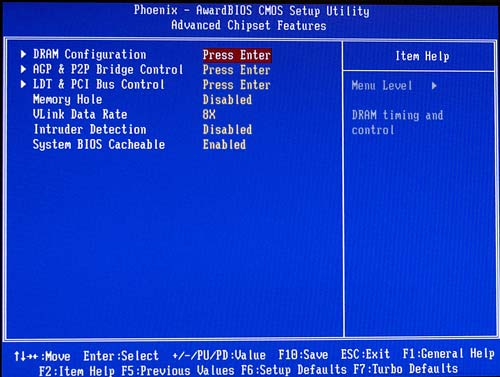
Advanced Chipset Features has submenus for DRAM and Hypertransport timings.

AOpen provides a very complete selection of memory timing adjustments in the DRAM submenu.
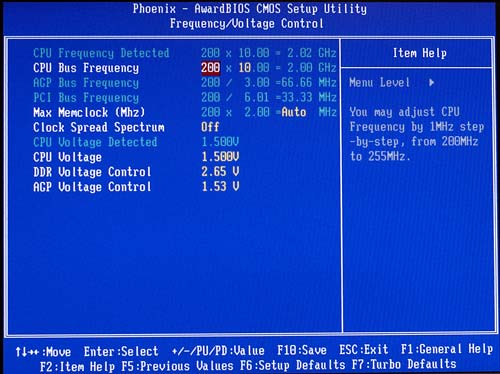
Frequency and Voltage adjustments are in this submenu. In addition, AOpen provides a readout on PCI and AGP frequencies. We were not surprised to see 33/66 at 200. Further testing with a PC Geiger showed that PCI/AGP was actually ratio-controlled, similar to what we have seen on Abit VIA K8T800 boards for Athlon 64.
Submenus in Frequency/Voltage Control allow a wide range of options.
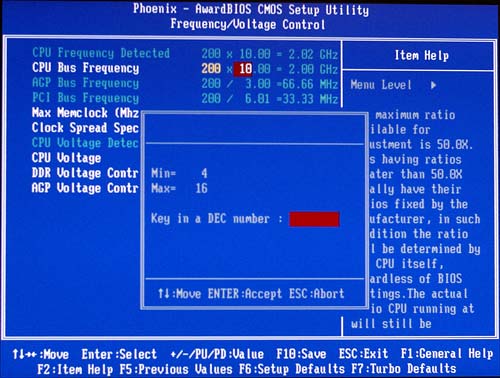
CPU multipliers below the rated speed can be selected in the BIOS. With a 3200+, the multiplier was 10, and we found values below 10 did work as selected. This capability means that the FSB adjustment to just 255 needs to be expanded by AOpen. We were able to reach 9x240 and 8x252 with our test 3200+ (10x200). With ratio adjustments, and ratio-driven PCI/AGP frequencies, you should be able to squeeze the most from high-speed memory with the AK86-L.
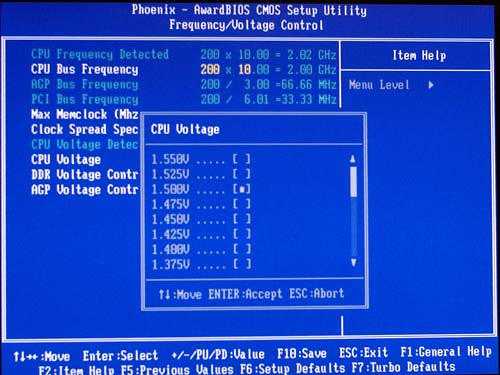
While CPU voltage can be adjusted from 0.8V to 1.55V, enthusiasts would prefer to see more voltage available on the top - to about 1.7V.
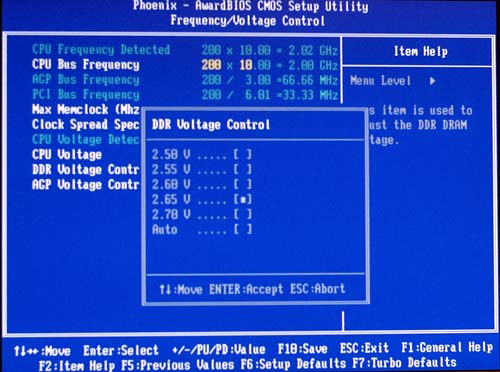
AOpen includes Memory Voltage adjustments from 2.5V to 2.7V in 0.05V increments. With some high-speed memory now warranting performance to 3.0V, this would be a better match to the other board capabilities with a wider range of memory voltage selections.
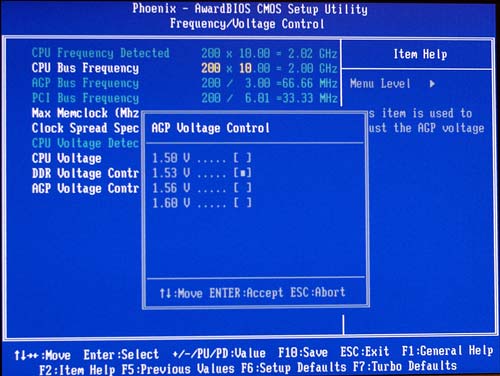
AGP voltage options are 1.5 to 1.6 in fine 0.033 increments.

The AK86-L includes smart fan controls in the Silent BIOS/HW Monitor section. You will also find a complete report of voltages. Beginning with the 1.06M BIOS, AOpen reports that they have added the AMD Athlon 64 Cool n Quiet feature.
The tweaking options in the AK86-L BIOS are outstanding for a production BIOS. There is very little to complain about in the options that are offered. However, the memory voltage and CPU voltage ranges need to be expanded to match the real capabilities of this board. A 200 to 255 CPU adjustment is OK, but a range to 300+ would be a better match to a BIOS providing CPU multiplier adjustments. AOpen has done a great job with the BIOS, but most Computer Enthusiasts would prefer to see wider adjustment ranges on this Athlon 64 motherboard.










22 Comments
View All Comments
Pumpkinierre - Monday, February 16, 2004 - link
In your update you say the new BIOS 1.06q includes cpu multipliers. But the old BIOS had that. So does this mean a larger range ie 0.5x divisions? Also now that you've got the Geiger, could you check the PCI lock at several clockspeeds?This is important to me as my interest in purchasing an a64 is to run it at high clockspeed (with only a mild o'clock) as I believe this would substanstially improve gaming performance. Of course this is also dependent on fast low latency DDR 466-500 being available- still yet to occur!.
Boonesmi - Thursday, February 12, 2004 - link
what about agp/pci lock? have you been able to test it yet??Wesley Fink - Thursday, February 12, 2004 - link
AOpen has just sent a revised BIOS 1.06Q, which adds vDimm adjustments from 2.5 to 3.0V in .05V increments. This is an outstanding upgrade from the 2.7v max vDimm in the BIOS we tested and makes the AK86-L one of the best 754 boards available for memory overclocking.A kind soul is hosting the 1.06q BIOS and a link has been added to the review.
JTDC - Tuesday, February 10, 2004 - link
Does anyone know where the 1.06 BIOS revision can be found? I cannot see it on the AOPEN site. Any suggestions as to where I can look?peonyu - Friday, February 6, 2004 - link
I have a Aopen board [not this one though,damn] and the options on it are awesome, same with its stability and performance. The only prob though is the same that this board has - VERY low voltage settings. For reasons i dont understand Aopen is very stubbern with allowing higher voltages, it happens with every board they release. So until they get past that and release a update which increases voltage I dont think it would be worth picking one of these up if your into overclocking.Shinei - Thursday, February 5, 2004 - link
Does Athlon 64 rely on timings as much as the Athlon XP did? I didn't think it did, considering the bandwidth it can use eclipses even the Pentium 4's...As for the article, now I really wish I'd waited a few months to upgrade, instead of going straight for the GA-7N400P2/2800+ in December...
Pumpkinierre - Thursday, February 5, 2004 - link
It would have been nice if you had included some benchmark results at the different multiplier o'clocks or even standardised to 2gig (ie 9x222,8x250) now that you have an A64 board that doesnt have memory, multiplier, HT or (from initial observations) AGP/PCI lock issues. Naturally memory latency settings would have to be kept the same. My pet theory with the A64 is that increasing the RAM speed and lowering memory latency (which appears difficult on many a64 mobo/memory combinations) would be as good as a standard o'clock which to date has'nt been the a64's strong point. This seems like the right board but we're still waiting for CAS2 DDR500.Boonesmi - Thursday, February 5, 2004 - link
dang i really like that board.when are you expecting the "PCI Geiger"??
hehe i want an update :)
Wesley Fink - Thursday, February 5, 2004 - link
#1 - Four "3-pin" fan headers is correct, and the typo is fixed.#2 - We will be reviewing a few of the memory brands you mention in a few weeks. A socket 754 board will be included in the tests.
bhtooefr - Thursday, February 5, 2004 - link
Damn, I want one! Of course, it would be even better if it were Micro ATX... (I've already got a mATX case, and it's very small)